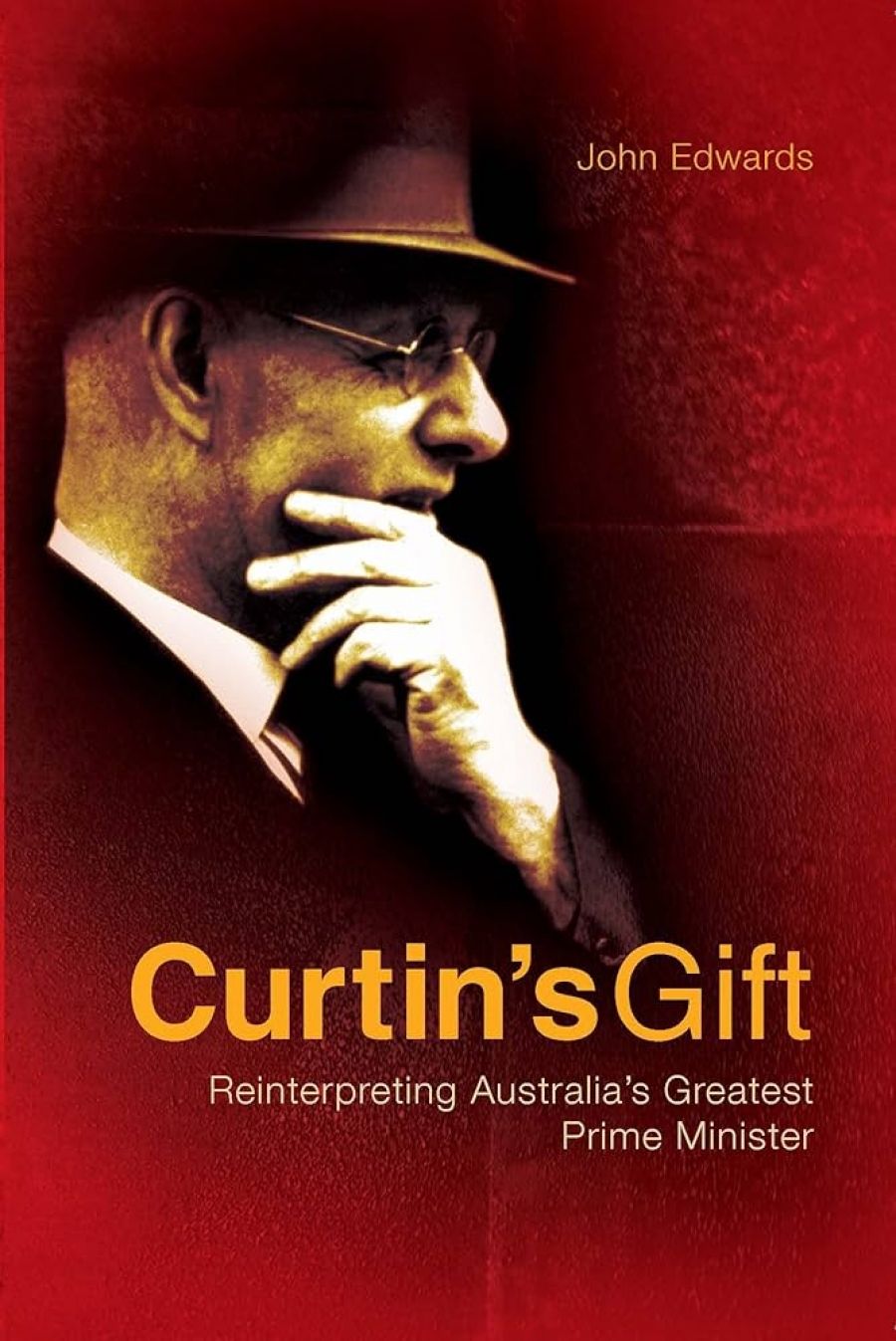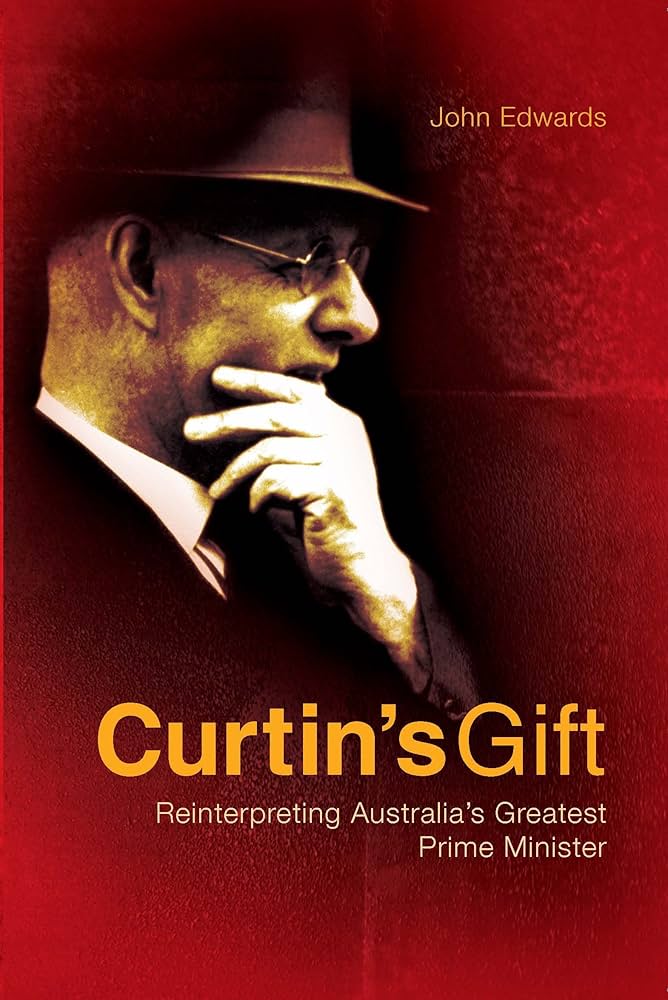
- Free Article: No
- Contents Category: Politics
- Review Article: Yes
- Article Title: The myth of Saint Jack
- Online Only: No
- Custom Highlight Text:
John Curtin was recently voted Australia’s best prime minister by a panel of nine scholars of political leadership (The Age, 18 December 2004). He narrowly won over Robert Menzies (by one vote), but easily beat the likes of Bob Hawke, Ben Chifley and John Howard – in that order. Given that Curtin was prime minister for less than four years, while Menzies ruled for eighteen years, and given that most of Curtin’s policies were tough austerity measures of wartime preparation, his enduring reputation as Australia’s best prime minister is surely remarkable. Then along comes economist and former Keating adviser John Edwards, who says that Curtin’s deification has been pronounced for all the wrong reasons.
- Book 1 Title: Curtain's Gift
- Book 1 Subtitle: Reinterpreting Australia's greatest prime minister
- Book 1 Biblio: Allen & Unwin, $35pb, 198pp, 186508 704 1
- Book 1 Cover Small (400 x 600):

- Book 1 Cover (800 x 1200):

Jack Curtin (1885–1945) is a dream character for historical study or biography: a former socialist and union journalist; a self-educated economist; an orator who was gaoled for sedition in World War I, for opposing conscription; a reformed alcoholic; a man who wrestled with his own demons and anxieties, and those of his fractured party; a successful wartime commander who held his nerve and sent conscripts to war; and a prime minister who was roundly praised by both colleagues and political foes alike. He also served as prime minister during the darkest years of World War II, when Australia faced invasion from Imperial Japan – a time of immense crisis, but also one when political leaders had an opportunity to attain greatness.
But this is not the Edwards tale. According to Edwards, ‘we have got Curtin seriously wrong’. In Curtin’s Gift: Reinterpreting Australia’s Greatest Prime Minister, he has set out to bring us ‘the real Curtin story’. Here is not only the main argument but also the nub of the project. Edwards dons the cloak of the contrarian – using counter assertion, sweeping generalisations and bombast. He subscribes to the ‘debunking myths’ school of biography, using the skills of the sophist to manufacture arguments with the benefit of hindsight. He hopes, with this short book, to launch his own version of the ‘History Wars’ where the thrill of the argument is more important than any of the assembled facts. The result is a little disappointing. This is pop revisionist history taken to new polemical heights, where biography appears as the art of the contrary overstatement and monocausal interpretations of past events and motivations.
Some of the myths are widely shared, such as the view that Curtin brought the troops home from the Middle East, or that he redirected our defence and foreign policy away from Britain and toward the US. Others are embroidered by Edwards: the notion, for instance, that Curtin was reluctant to assume political power and was either lacking in courage or was unpatriotic in refusing a national coalition with Menzies in 1940–41.
Against these dragons, Edwards then demolishes Curtin’s war record as leader (there is always someone else, somewhere else more important and more in control than the Australian prime minister). Curtin is chastised for not declaring war on Japan at the cabinet meeting held on 8 December 1941 – when he prudentially waited for the US to declare war the next day, followed by Britain. Edwards argues that Curtin was not anti-British because he appointed the king’s brother George, the Duke of Gloucester, as governor-general and draped himself in a Union Jack at a rally. But who has ever argued that Curtin was anti-British, instead of just realising that Britain couldn’t defend us and the US could? The wisdom of hindsight allows Edwards to claim that Curtin exaggerated the threat of invasion for his own political ends. His logic runs: as the ‘battle for Australia’ never eventuated, any talk of it must have been hyperbole – a dubious proposition.
Edwards tries to show that Curtin was no ‘Saint Jack’ – the ‘accidental hero’ pushed into high office. But all accounts of Curtin’s rise in politics stress his ambition and his determination to seek public office. He was a career politician who stood for office four times before he won, was then defeated and stood again, was ambitious enough to feel he should have been in the Scullin ministry, and was keen to stand for the Labor leadership in September 1935. His refusal to join with the Menzies United Australia Party government at the outbreak of the war was simply prudence, not some Machiavellian intent. The myth of Saint Jack that Edwards tries to debunk is more straw man than real.
On to his more substantial point that Curtin built the modern Commonwealth, much of Edwards’s argument rests on Curtin’s youthful experiences – itinerant working-class upbringing, a flirtation with socialism and a quest for self-education. The Depression and the confusion over economic policy of the Scullin government were also major influences on his thinking. Partly, Edwards’s case is one of acknowledging Curtin’s role in establishing the bases for the Keynesian postwar reconstruction policies usually attributed to Chifley. He makes a strong plea for rewriting Curtin back into the story of government control over banking and monetary policy.
Much of Edwards’s argument that Curtin transformed the Commonwealth hinges on intent – did Curtin intend the Commonwealth to hang onto the special wartime measures introduced in 1942 (such as the transfer of income tax to the federal government for the duration of the war and for one year after)? It is not clear from the historical record that in 1942 (or even to the end of the war) the Labor government intended to retain the wartime powers and to maintain them through the postwar era and throughout the ‘long boom’. Moreover, while Edwards is triumphalist over Curtin’s gambit to wrest income taxes from the states, he provides no evidence that Curtin intended to use central uniform taxation as a major change to Australian federalism. A cynic might argue that the Commonwealth simply changed its mind after the war (something the premiers had warned of at the time).
Full employment is another issue. Federal Labor promised full employment as an inspirational policy to their side of politics, worried about a postwar recession. But while the policy was translated into a White Paper (and sold overseas), the main commitments were so watered down by the same government as to be almost meaningless. Curtin presided over perhaps the biggest propaganda exercise Australia has ever seen.
It is clear that Curtin, along with many of his Labor colleagues, wanted to see a more active Commonwealth in economic affairs, and had long sought to bring the banks under some form of popular control. It is not clear that Curtin set out to transform the Commonwealth and to build the modern policy system we have today. This book will not settle the argument.


Comments powered by CComment